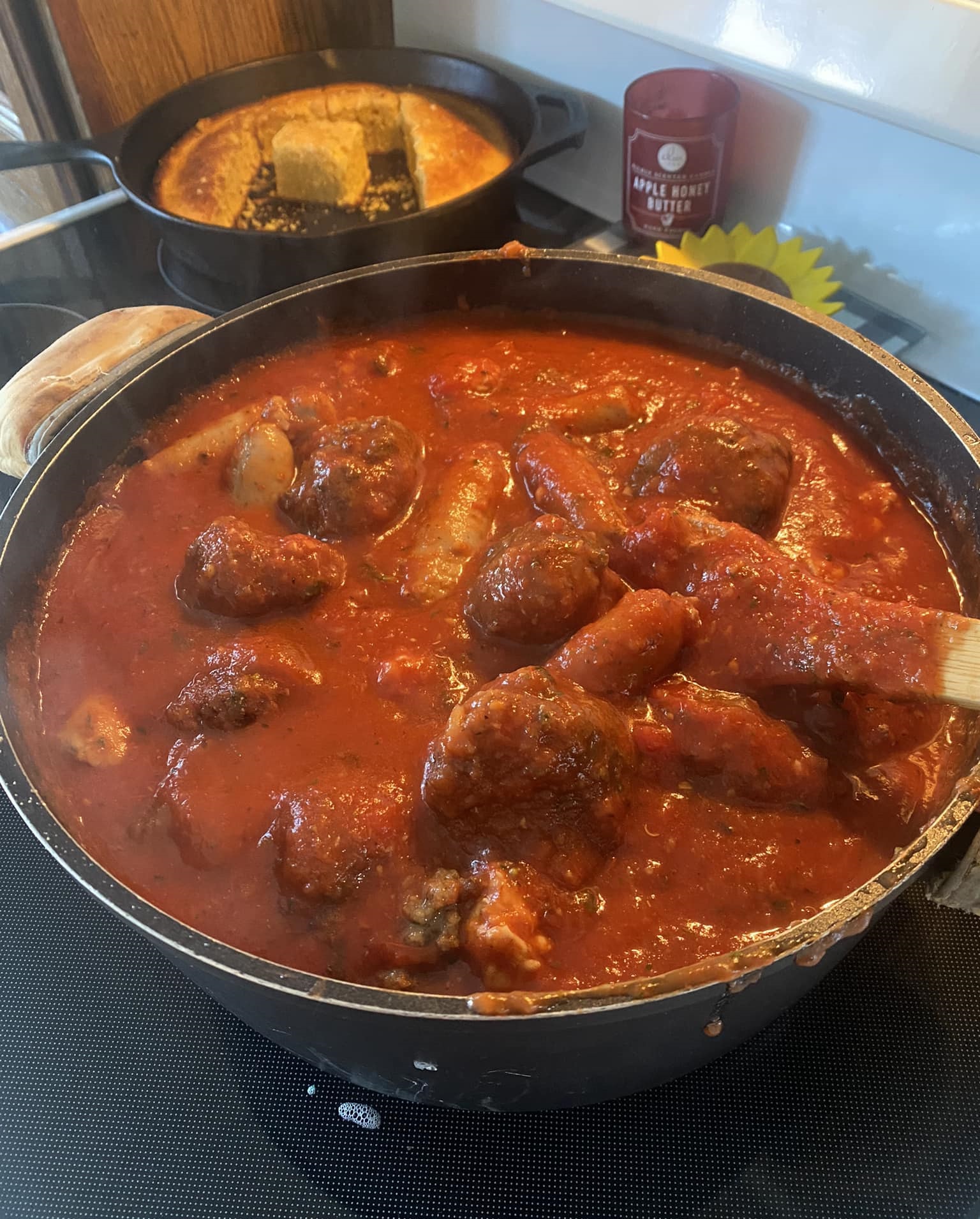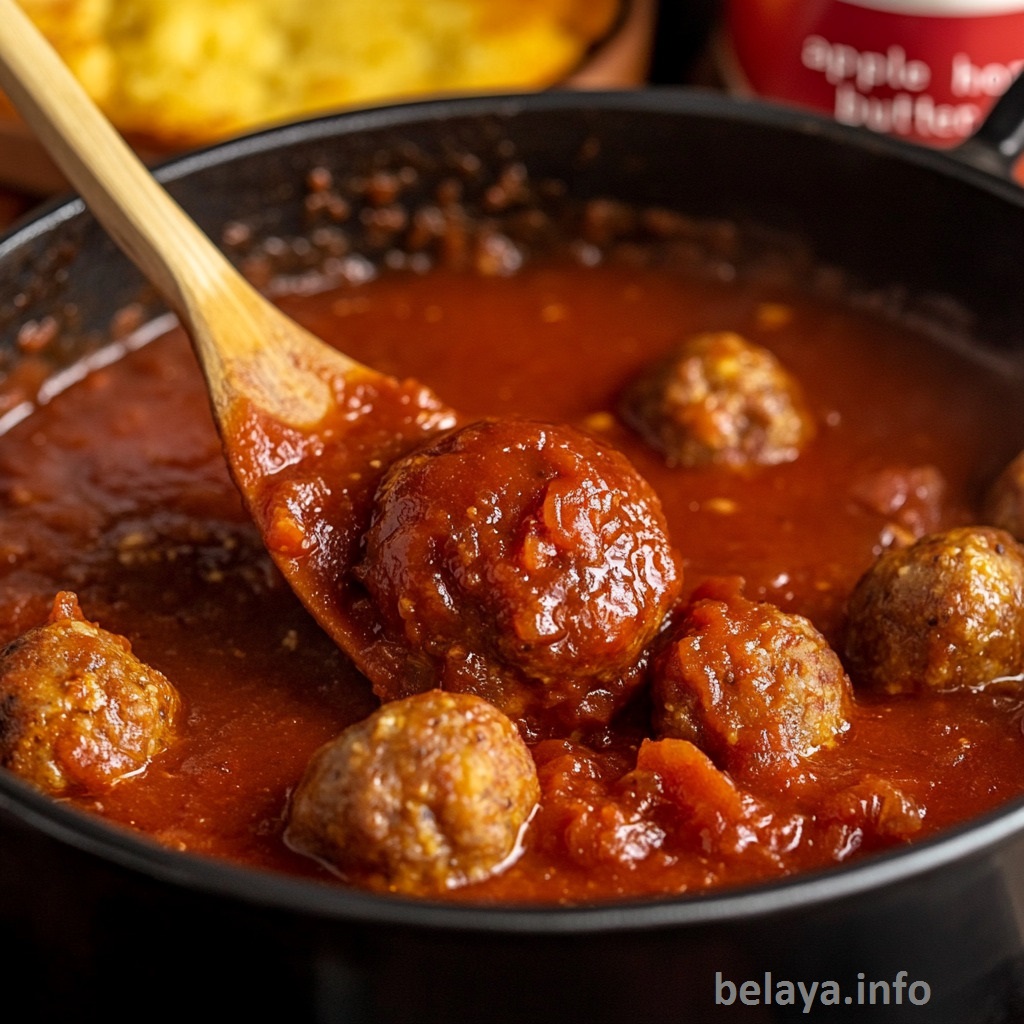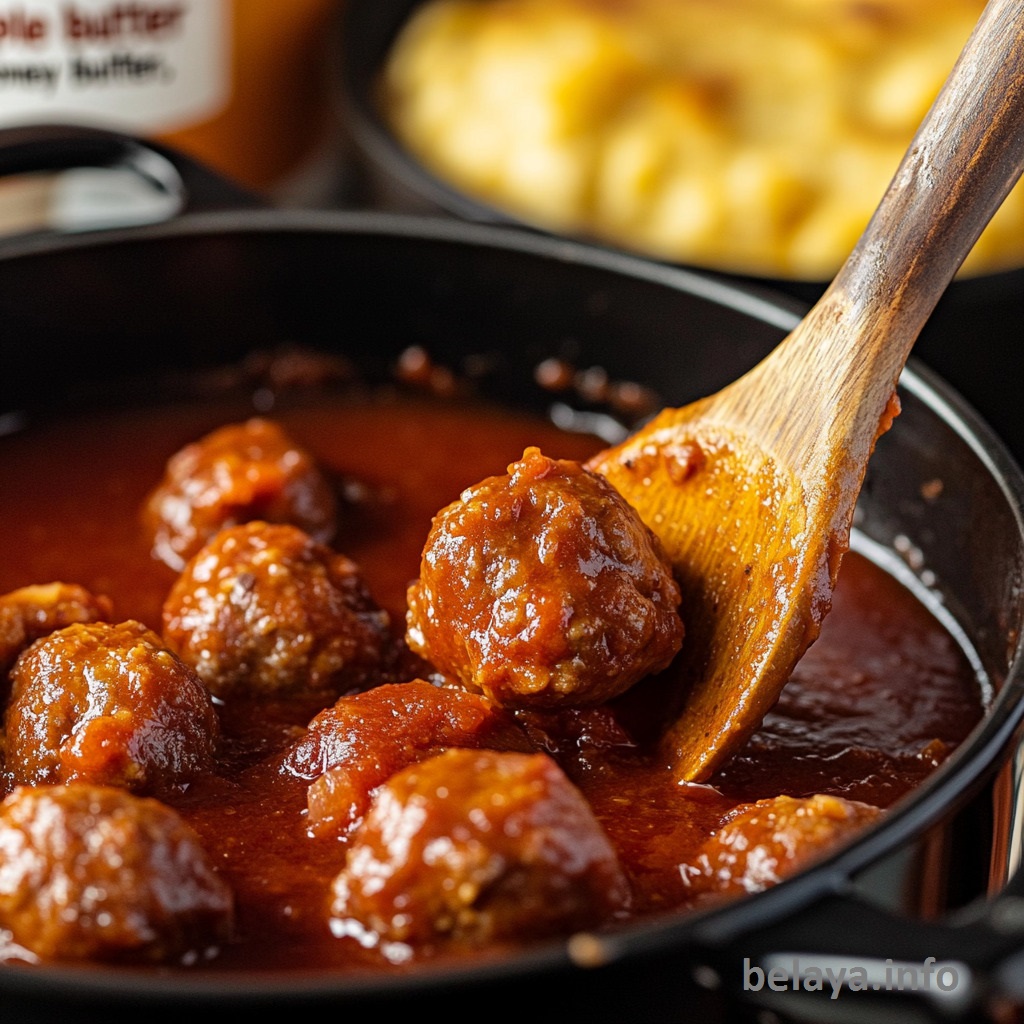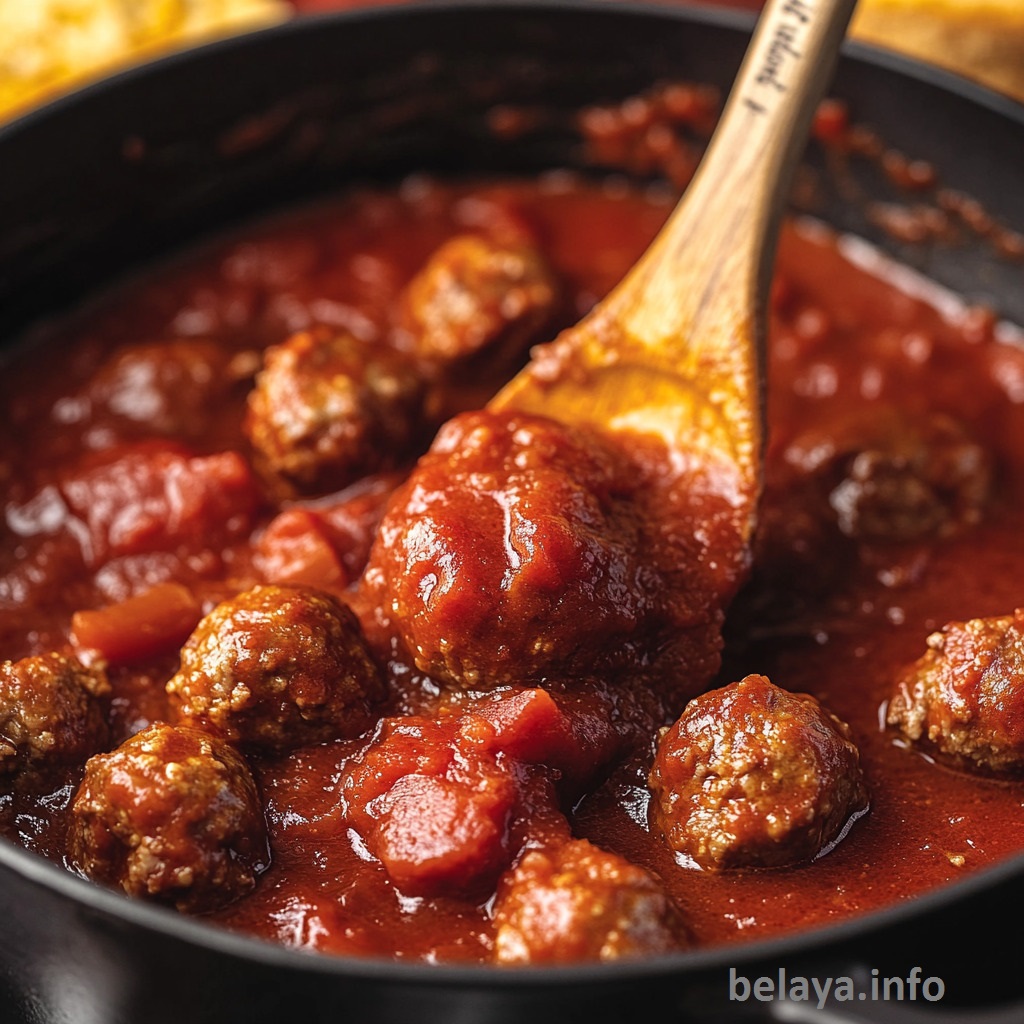Italian Sunday Gravy
Italian Sunday Gravy isn’t just a meal—it’s a ritual. Passed down through generations, this slow-simmered sauce is the heart of a Sunday gathering, where family, time, and aroma are the main ingredients.
With its deep, layered base of tomatoes, garlic, and olive oil, Sunday Gravy transforms into something extraordinary as tender cuts of pork, Italian sausage, and handmade meatballs slowly release their richness into the pot. Each hour of simmering builds depth, each stir stirs memory.
Served with pasta and finished with ricotta and Pecorino Romano, this dish is the kind of food that nourishes not only the body but the soul—bringing people together around a table of warmth, history, and unmistakable Italian comfort.

Why People Will Love The Italian Sunday Gravy Recipe:
It Honors Italian Tradition and Family Rituals
Sunday Gravy is more than food—it’s a timeless tradition of gathering, storytelling, and love simmered over low heat. It evokes the warmth of Italian family kitchens and multigenerational meals.
Layers of Meaty, Slow-Cooked Flavor
Combining pork, sausage, and meatballs infuses the sauce with incredible depth and richness, as each type of meat contributes its own texture and flavor—creating a luxurious, hearty ragu.
It Turns Simple Ingredients into Something Extraordinary
With just tomatoes, onion, garlic, herbs, and a few pantry staples, this recipe slowly transforms into a sauce that’s silky, complex, and soul-satisfying—proof that time and love are powerful seasonings.
Perfect for Sharing and Feasting
Designed to feed a crowd, this dish becomes the centerpiece of any meal, inviting everyone to the table. It’s ideal for celebrations, Sunday suppers, or comforting reunions.
A Complete, Customizable Meal
Whether ladled over pasta, spooned onto crusty bread, or enjoyed with a side of ricotta and Pecorino, Sunday Gravy is versatile, comforting, and endlessly adaptable to personal or regional tastes.

Key Ingredients:
Assorted Pork Cuts (Loin, Chops, Ribs, or Neck Bones)
These cuts form the foundation of the gravy’s depth, slowly breaking down over hours to infuse the sauce with savory, marrow-rich flavor. The meat becomes fall-apart tender, embodying the soul of slow cooking.
Italian Sausage (Hot, Sweet, or Both)
The sausage brings boldness and spice, rendering fat into the sauce that enhances its richness. Using both varieties creates a harmonious balance between heat and sweetness, true to southern Italian kitchens.
Homemade or High-Quality Meatballs
Soft, seasoned meatballs soak in the sauce and absorb its tomato richness, while releasing aromatic herbs and breadcrumbs back into the gravy—blurring the line between sauce and main dish.
Whole Peeled or Crushed Tomatoes
These are the heart of the sauce, breaking down into a velvety base as they simmer. Whole peeled tomatoes add texture and brightness, while crushed ones provide a smoother consistency. Either way, they’re the canvas for every other flavor.
Tomato Paste
Used to deepen the umami and thicken the base, tomato paste adds a concentrated tomato richness that anchors the gravy, allowing the long simmer to coax out even more flavor.
Onion, Garlic, and Red Chili Flakes
These aromatic elements form the flavor backbone of the sauce. The onion softens into sweetness, the garlic perfumes each bite, and a pinch of chili flake awakens the entire dish with gentle heat.
Bay Leaves and Fresh Parsley
These herbs infuse the gravy with a woodsy, herbal complexity. Bay leaves lend subtle bitterness and balance, while parsley brightens the final result with a touch of green freshness.

Expert Tips for Italian Sunday Gravy
Sear Each Meat Separately for Maximum Flavor
Don’t rush the browning step. Searing pork, sausage, and meatballs separately allows each to develop a deep, golden crust, which creates fond (those browned bits on the pot bottom). Deglazing this later with tomato adds a rich, meaty undertone to your sauce.
Layer the Meat Strategically
Add the pork first (it needs the most time to break down), followed by sausage and then pre-cooked meatballs later in the simmer. This keeps the textures distinct and prevents the meatballs from falling apart too soon.
Use Whole Peeled Tomatoes for Texture Control
Whole tomatoes offer more flexibility—you can break them apart for a rustic sauce or blend them for a smooth base. Crushed tomatoes work too, but they often cook down faster and don’t yield as much slow-cooked body.
Simmer Low and Slow—Don’t Boil
A gentle simmer is key. High heat will cause the meats to toughen and the sauce to reduce too quickly. Let the sauce bubble lazily for 3+ hours, stirring occasionally to prevent scorching at the bottom.
Balance Acidity with a Pinch of Sugar or Butter
Depending on the tomatoes and meat, the sauce may taste a little acidic. A tiny pinch of sugar or knob of butter can mellow the acidity without making the sauce sweet, preserving that signature richness.
Rest the Gravy Before Serving
Once the cooking is complete, let the sauce sit (covered, off heat) for 15–30 minutes. This helps the flavors settle and deepen, and makes the meat easier to carve or portion for serving.
Toss Pasta with Sauce Separately
Don’t pour sauce directly onto dry pasta. Instead, mix cooked pasta in a separate bowl with a ladle of gravy to coat every strand—this creates a perfect first layer before guests spoon more sauce or meat on top.

Italian Sunday Gravy
Ingredients
2 tablespoons extra virgin olive oil
2-3 lbs pork loin, pork chops, ribs, and/or neck bones
Kosher salt and black pepper to taste
1 small yellow or sweet onion, finely diced
5 cloves garlic, very thinly sliced
Pinch of red chili flakes
3 tablespoons tomato paste
2 (28-ounce) cans whole peeled tomatoes or crushed tomatoes
2 bay leaves
1 tablespoon finely minced Italian parsley
Pinch of sugar (optional)
1½ lbs Italian sausage (hot, sweet, or both)
1 batch homemade Italian meatballs or 16-20 store-bought meatballs, cooked
Pasta for serving
Grated Pecorino Romano cheese for serving
Ricotta cheese for serving
Instructions
Step 1:
Heat the Oil Begin by warming the olive oil in a large pot or Dutch oven over high heat.
Season the pork with salt and pepper, then sear it until it is nicely browned on all sides.
Remove the pork and set it aside.
Step 2:
Sauté Onions Reduce the heat to medium and add the diced onion to the pot.
Sauté until the onion becomes soft, about 5 minutes.
Step 3:
Add Garlic and Chili Flakes Incorporate the sliced garlic and red chili flakes, cooking for an additional 2 minutes.
Step 4:
Stir in Tomato Paste Mix in the tomato paste and cook for about 1-2 minutes until it’s well combined with the onions and garlic.
Step 5:
Add Tomatoes and Seasonings Pour in the whole peeled or crushed tomatoes, bay leaves, and minced parsley.
Season with salt and pepper, then fill one empty tomato can with water and add it to the pot.
If using whole tomatoes, break them apart with a wooden spoon or use an immersion blender for a smoother texture.
Step 6:
Combine and Simmer Bring the sauce to a boil, then add the pork, sausage, and meatballs back into the pot.
Reduce the heat to low and allow it to simmer gently for about 3 hours, stirring every 20 minutes to prevent sticking.
Step 7:
Taste and Serve Once the sauce has thickened and the pork is tender, taste and adjust seasoning if necessary.
Remove the bay leaves and any bones from the pork.
Transfer the meats to a serving platter.
Step 8:
Pasta and Garnishes Toss the cooked pasta with a bit of sauce, then serve the remaining sauce in gravy boats.
Present the platter of meats alongside, along with bowls of grated Pecorino Romano and ricotta cheese for guests to enjoy.
Enjoy this rich and hearty Italian dish!

Important Notes When Making Italian Sunday Gravy
This Is a Sauce That’s Meant to Feed a Crowd—And Tell a Story
Italian Sunday Gravy isn’t just about dinner—it’s about ritual, patience, and shared abundance. Plan for plenty of time and prepare to enjoy the process, not just the result. It’s a dish best served around a full table, with second helpings and stories flowing.
Choose Bone-In Cuts for Deeper Flavor
Whether it’s pork neck bones, country-style ribs, or bone-in chops, the bones release gelatin and marrow into the sauce during the long simmer, giving the gravy a rich body and soulful complexity that boneless cuts simply can’t match.
Don’t Rush the Simmer—Time Builds Flavor
This sauce needs at least 3 hours to develop its signature depth. The meats soften and infuse the tomatoes with savory, umami-laden richness, while the sauce reduces gently into a thick, spoon-coating consistency. Stir every 20 minutes to avoid scorching the bottom.
Cook the Meatballs Separately First
Meatballs added raw may break apart or become too soft. Brown or bake them first until they have a firm exterior. Then, simmering them in the sauce allows them to absorb flavor while holding their shape.
Expect Variability—Taste and Adjust as You Go
Different tomatoes, meats, or even stove temperatures can impact your result. Always taste your sauce halfway through and near the end. You may need a pinch of sugar to soften acidity, more salt for roundness, or a drizzle of olive oil to finish.
Plan for Leftovers—It’s Even Better the Next Day
Like many stews and braises, Sunday Gravy deepens in flavor overnight. The sauce thickens, the seasonings meld, and the meat becomes even more tender. It reheats beautifully and freezes well for future meals.
Keep the Sauce and Meats Separate Until Serving
To avoid breaking down the tender meat or overcrowding the pasta, serve meats on a platter and sauce in bowls or gravy boats. This also lets guests customize how much meat or sauce they want with their pasta.
How to Enjoy Italian Sunday Gravy After Cooking
Let the Gravy Rest Before Serving
After the long simmer, let the pot rest off the heat for 15–30 minutes. This helps the flavors mellow and marry, and allows the fats to settle slightly.
Skim excess fat from the top if desired, or leave it for richness—it’s personal preference, but many Italian grandmothers would say, “leave it in.”
Set a Family-Style Table
Sunday Gravy is meant to be shared. Serve the pasta, meats, and sauce separately:
Toss the pasta in a bit of the sauce for flavor.
Arrange the meats—sausage, pork, and meatballs—on a large platter.
Provide gravy boats or small bowls of extra sauce so everyone can ladle their own.
Set out grated Pecorino Romano and fresh ricotta in small bowls for extra richness.
Choose the Right Pasta and Portion It Properly
Traditionally served with rigatoni, ziti, or spaghetti, choose a pasta that can hold the thick sauce.
Toss pasta with sauce in a warm bowl, not on the plate, for even coating.
Plate individual portions, then let guests spoon more sauce and choose their meats.
Pair Thoughtfully with Wine or Bread
Serve with a hearty Italian red wine, like Chianti, Sangiovese, or Barbera. These wines cut through the richness of the meat and complement the acidity of the tomatoes.
Offer crusty Italian bread on the side—for scooping sauce, wiping plates, or soaking up every last drop.
Balance the Meal with a Light Side
Consider pairing with:
A simple green salad (like arugula with lemon vinaigrette)
Roasted vegetables or garlicky sautéed greens
A small antipasto plate to start
This keeps the meal balanced and digestible, especially with a rich, long-simmered sauce like Sunday Gravy.
Store Leftovers Properly and Reheat Gently
Let leftover gravy cool completely, then refrigerate in airtight containers.
The flavors intensify overnight—many believe it tastes even better the next day.
Reheat gently over low heat, adding a splash of water if the sauce is too thick.
Savor the Tradition
Most importantly, enjoy Sunday Gravy the way it was intended—slowly, with others, and with appreciation for the time and care behind it.
It’s not just a meal—it’s a Sunday tradition. Take your time.

Nutrition Information:
YIELDS: 8 | SERVING SIZE: 1
Calories: 350 kcal | Protein: 25 g | Carbohydrates: 15 g | Dietary Fiber: 2 g | Sugars: 4 g | Fat: 20 g | Saturated Fat: 7 g | Cholesterol: 70 mg | Sodium: 800 mg

Frequently Asked Questions:
What makes this sauce a “gravy” instead of just a tomato sauce?
In many Italian-American households, especially in the Northeast U.S., the term “gravy” refers to a tomato-based sauce enriched with multiple meats—like pork, sausage, and meatballs—slow-simmered for hours. The meats release their juices and fat into the sauce, creating a depth and richness that elevates it beyond a typical marinara.
Can I use only one type of meat instead of the full combination?
Yes, though you’ll sacrifice some depth. Using a mix of meats—pork ribs or neck bones, sausage, and meatballs—adds layers of flavor and texture. If simplifying, prioritize bone-in pork and Italian sausage, which provide the richest flavor base.
How do I keep the meatballs from falling apart during the simmer?
Always brown or bake the meatballs before adding them to the gravy. This creates a crust that helps them hold their shape and adds another layer of flavor. Adding them during the last 1–1.5 hours of cooking helps prevent over-softening.
Can I make this ahead of time?
Absolutely. Sunday Gravy tastes even better the next day after the flavors have had time to meld. Let it cool completely, refrigerate overnight, and gently reheat on the stovetop. It also freezes well for up to 3 months.
What’s the best pasta to serve with Sunday Gravy?
Go with sturdy, tubular pasta like rigatoni, ziti, or paccheri. These shapes hold the thick sauce and meaty bits beautifully. Long noodles like spaghetti work too, but avoid delicate pastas—they’ll get overwhelmed by the rich gravy.
Why is it important to sear the meats before simmering them in the sauce?
Searing the pork and sausage first develops a deep, caramelized crust through the Maillard reaction, which adds rich umami flavor to the sauce. The browned bits (fond) left in the pot also infuse the tomatoes with savory complexity once deglazed.
Do I need to use an immersion blender if I’m using whole tomatoes?
Not necessarily. If you prefer a rustic texture, simply crush the tomatoes by hand or with a wooden spoon in the pot. For a smoother consistency, use an immersion blender before adding the meat, or opt for crushed tomatoes instead.
How do I prevent the sauce from burning at the bottom of the pot during the long simmer?
Use a heavy-bottomed Dutch oven or stockpot, keep the heat low, and stir the sauce every 15–20 minutes—scraping the bottom well. This helps prevent scorching and ensures even cooking during the 3-hour simmer.
Can I make this in a slow cooker or pressure cooker?
Yes—with adjustments. For a slow cooker, sear the meats and sauté the aromatics first on the stovetop, then transfer everything to the cooker and cook on low for 6–8 hours. In a pressure cooker, reduce liquid slightly and cook on high pressure for about 45–60 minutes, followed by a natural release.
When should I adjust seasoning—early or at the end?
Always wait to adjust salt, pepper, or sugar until the last 30 minutes. As the sauce simmers and reduces, flavors concentrate—so seasoning too early can lead to over-salting or unbalanced flavor. Taste toward the end and season accordingly.